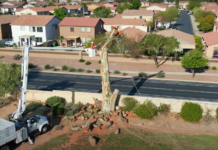Chairman Sandie Smith didn’t know what to expect when she started tinkering with the idea of a partnership meeting between people interested in Pinal County issues. Following the Friday meeting held at the Casa Grande Holiday Inn, the District 2 Supervisor was pleasantly surprised.
“An absolute success,” a beaming Smith said. But she did caution that there is still a lot of work ahead before there is any progress made. “We took a huge step with the success of this meeting, but we have to keep on working to bring in more partners that have a stake in the success of our County. When you address issues such as roads, you cannot do that in a vacuum.”
Over 300 people ranging from residents to non-residents, elected officials to developers, packed the Holiday Inn conference room. The participants were on hand to hear and discuss issues relating to growth and transportation matters inside Pinal County.
Welcoming the participants were Chairman Smith, fellow Pinal County Supervisor David Snider and Casa Grande Mayor Chuck Walton. District 1 Supervisor Lionel Ruiz was ill and was unable to make the meeting.
Supervisor Snider greeted the crowd to his home district and said one of the many positive results of bringing people into Pinal County for this type of meeting was to see what was actually happening with growth issues.
“This gives you a chance to take a look at Pinal County coming in and going out,” Supervisor Snider said. “There are two benefits to this. One, you will want to live here and two, you will see the changes in Pinal County.”
Supervisor David Snider addresses the crowd at the inaugural Pinal Partnership meeting.
Participants heard a presentation from economist Elliott Pollack gave a detailed lecture dealing with the booming housing market in the County, along with population projections.
Pollack compared the growth from the greater Phoenix area to an expanding balloon. “Once the edge of the balloon gets there, you have explosive growth,” Pollack related to the group. “It is difficult to predict, but once (growth) starts, it won’t stop.”
Using a chart, Pollack announced that the housing market is beginning to cool in Gilbert and Chandler due to the lack of available land to build and the high price of homes. During that same time, the housing market in Pinal County has come to life due in part to the affordability of housing. Comparing housing costs, Pollack said that the average sales price in Maricopa County is $270,145; while Pinal County is averaging $189,838.
“Affordability is an issue,” Pollack said. “There were more housing permits granted in Casa Grande than there were in Mesa.”
Fellow economist Rick Merritt presented population estimates that could place Pinal County with over one million residents as early as 2020. “We’re on the cusp of this happening,” Merritt said.
The growth, Merritt said, means the need for roads. Examining Maricopa County, Merritt told the gathering that they began a long range transportation study in 1985. The results have seen the construction of roadways like U.S. 60 and the 101 Loop.
“Now is the time to start thinking for 20 years down the road,” Merritt said.
Supervisor Snider did address the planning issue with Merritt and the attendees by stressing that Pinal County is currently completing a regional transportation plan and the cities are completing a small area transportation plan.
“The plan is to stay ahead of the curve,” Snider said.
The next meeting for the Pinal Partnership is slated for November 3. By that time the group hopes to have hired an executive director for the Partnership.

![Shred-A-Thon to take place tomorrow An image of shredded paper. [Pixabay]](https://www.inmaricopa.com/wp-content/uploads/2024/03/shredded-paper-168650_1280-218x150.jpg)












![Shred-A-Thon to take place tomorrow An image of shredded paper. [Pixabay]](https://www.inmaricopa.com/wp-content/uploads/2024/03/shredded-paper-168650_1280-100x70.jpg)


